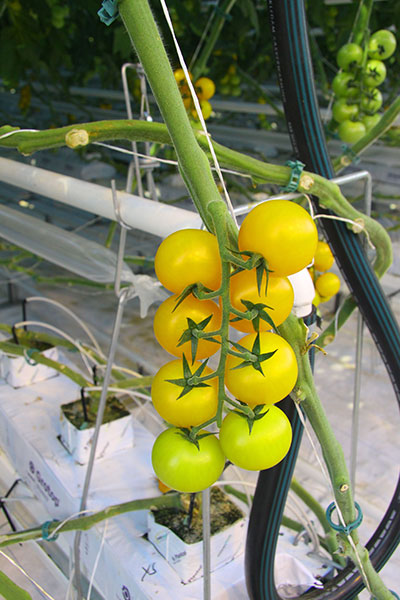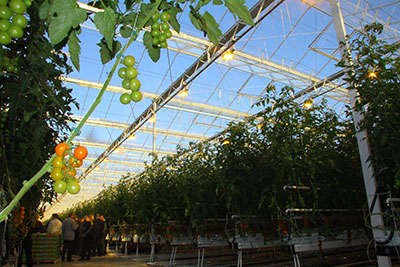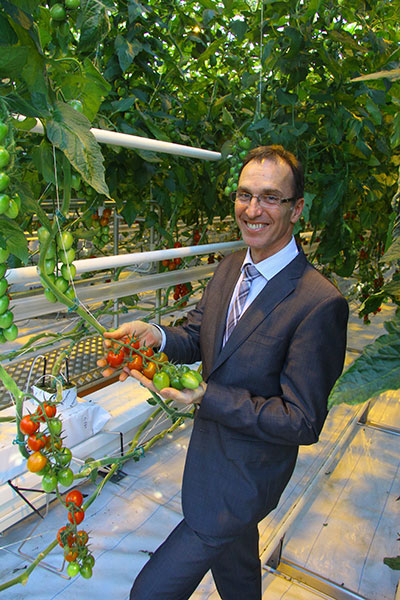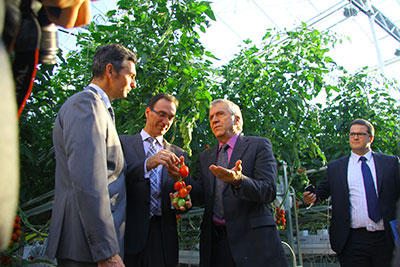
Eating tomatoes grown near a landfill site may not initially sound
appetizing, but it could be the most eco-friendly way to enjoy local
tomatoes all year round.
Eating tomatoes grown near a landfill site may not initially sound appetizing, but it could be the most eco-friendly way to enjoy local tomatoes all year round.
 |
|
| One of the specialty tomato varieties. PHOTOS BY ANDRé DUMONT Advertisement
|
Last fall, Productions Horticoles Demers put into production a new three-hectare (323,000-square-foot) tomato greenhouse at a Waste Management landfill in Drummondville, Quebec.
The ribbon-cutting ceremony was attended by local elected officials, as well as by François Gendron, the province’s deputy premier and minister of agriculture.
Earlier in the year, Waste Management put into service a 7.6 MW power plant with the capacity to supply 6,500 homes. Biogas from the sealed up landfill cells is burned to activate huge generators that feed electricity into the Hydro-Quebec grid.
So far, nothing groundbreaking: both electricity production and greenhouse production already exist near landfill sites. But in Drummondville, the tomatoes are a tad greener.
HOT WATER IS HEATED IN THE POWER PLANT
■ No biogas is used specifically to heat the greenhouse. The source of energy is the great amount of heat generated by the engines inside the power plant. If that heat weren’t transferred to water, it would simply be lost. The hot water is fed into pipes that carry it 600 metres to the greenhouse.
 |
|
| Three acres in size, the greenhouses are all glass and feature supplemental lighting.
|
‘‘Our hot water heating network is very similar to that of any other greenhouse,” said Jacques Demers, who runs the family tomato and berry farm with his brother Réjean. “Waste Management takes care of burning the biogas for its power plant and we simply use the residual heat.’’
The farm was founded by their parents 50 years ago in Saint-Nicolas, across the St. Lawrence River from Quebec City. The two greenhouses at that location total 2.5 hectares.
Demers tomatoes and berries are mostly sold in Quebec. The farm uses the motto “Fruits rouges, culture verte” (“Red fruits, green farming”), along with the ‘‘ecolocal’’ trademark.
‘‘Eating Demers tomatoes from Drummondville is an ‘ecolocal’ thing to do, that helps the regional economy and encourages production practices that have a softer impact on the environment,’’ Demers said.
The new greenhouse cost $12 million to build. Provincial government support totals $8 million, including a $5-million grant from the Bureau de l’efficacité et de l’innovation énergétique (provincial energy efficiency and innovation agency).
It is estimated that using residual heat will reduce annual greenhouse gas emissions by 15,000 tonnes by avoiding combustion of fossil fuels. This represents 5,000 fewer cars on the road over a 20-year period.
A 30-YEAR AGREEMENT FOR THE HOT WATER
■ Productions Horticoles Demers and Waste Management have signed a 30-year agreement. Demers doesn’t get its hot water for free, but the agreement goes a long way toward providing advantageous production costs, said Daniel Brien, operations manager at the landfill site.
 |
|
| Company president Jacques Demers.
|
‘‘At Waste Management, we wanted to go full circle,’’ Brien said. ‘‘We have been handling those biogases for a long time and now, we are using them two ways: we are producing electricity and heating a greenhouse.’’
The hot water from the power plant also heats a training facility, several service buildings and a water treatment plant. ‘‘We still have plenty of [hot water] energy available,” Brien said. “We are looking for other partnerships.’’
The landfill in Drummondville was started in 1984 and purchased by Waste Management in 1996. ‘‘Waste Management has been collecting data about its biogas for several years,’’ Demers said. ‘‘With such data, it is possible to model the biogas production for 20 years and beyond.’’
For Demers, it is a huge bonus to know that the only time he might be using biogas directly is if his backup boiler needs to be fired up should Waste Management’s power plant fail. Should things go completely wrong, the boiler can also run on propane. The greenhouse also has a two-million-litre holding tank, which stores hot water for the fluctuating heat demand.
LATEST TECHNOLOGIES INCORPORATED INTO GREENHOUSES
■ The new greenhouse boasts the latest technology: energy curtains, heat pipes running within the crop, and grow lights. The facility is six metres in height and is all glass.
 |
|
| Participating in the ceremonies were, left to right, Waste Management operations manager Daniel Brien, Productions Horticoles Demers president Jacques Demers, and Quebec Minister of Agriculture and Deputy Premier François Gendron.
|
The grow lights are central to an intercropping system that will allow the greenhouse to remain in production all year long. At the time of Greenhouse Canada’s visit, one could easily spot the missing growing medium blocks in every row.
Young tomato plants are installed in these spaces in July or August, in order for them to come into production around mid-October, when the production of mature plants starts to wind down.
Every row has two separate irrigation lines, to feed the old and young plants at different rates, according to their needs. The old growth will be pulled down in the fall to gradually increase the light reaching the younger plants.
SUPPLEMENTAL LIGHTING IS EXPENSIVE TO OPERATE
■ Using grow lights comes with a hefty hydro bill, but Demers hopes this system will allow him to capitalize on better prices throughout the winter months, when most Canadian tomato greenhouse operations halt production.
‘‘I know this will not be obvious, with all the produce coming in from Mexico at very low prices lately,’’ he admits.
Trucking tomatoes out of the Drummondville location involves a three-kilometre winding drive through mounds of domestic garbage capped with soil and tapped for their methane. This still brings Demers tomatoes halfway closer to Montreal, the province’s largest consumer market.
‘‘Our energy costs are lower than with any traditional source,’’ Demers says. ‘‘It gives us a clear competitive advantage and that’s why we bothered building here.’’
André Dumont is a freelance writer and photographer in Quebec.
Print this page